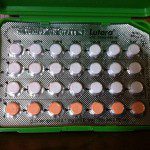![https://commons.wikimedia.org/wiki/File%3APackage_of_Lutera_Birth_Control_Pills.jpg; By ParentingPatch (Own work) [CC BY-SA 3.0 (http://creativecommons.org/licenses/by-sa/3.0)], via Wikimedia Commons](https://wp-media.patheos.com/blogs/sites/533/2016/12/800px-Package_of_Lutera_Birth_Control_Pills.jpg)
Three cases:
First, couples who can’t manage the week and a half wait of the idealized NFP cycle.
Second, couples where the ovulation signs are more difficult to read, leading to significantly more abstinence than the idealized 10 days.
Third, couples whose need to avoid pregnancy is much greater and who practice NFP with more conservatism, again, producing more abstinence than usual.
Obviously, there’s overlap between cases two and three.
Now, about case #1 I don’t have much to say. I know there are people who believe that it’s wrong to ask any amount of abstinence from couples, just as there are people who believe that everyone past puberty has a physiological need for regular sexual release. I’m just not interested in discussing this claim.
With respect to the issue of extended abstinence, though, there’s one thing that’s being overlooked:
All the forms of contraception that are on the market today, are there due to extensive research over the past half-century, both government- and Big Pharma-funded. They didn’t just appear out of nowhere.
How much money, if devoted to research with a different objective, would it take to solve the problem of extended-abstinence NFP? Let’s think about this.
To begin with, let’s consider the affected couples in more detail: there are multiple reasons for unclear interpretations/prolonged abstinence. (As context, very simply, prior to ovulation, one determines the start of the fertile period by either one’s past history or the start of cervical mucus; one determines the end of the fertile period either by temperature-taking or by the end of fertile-type cervical mucus, or both in combination.)
Breastfeeding, for some women, makes everything clear as mud, because they may experience a continuous discharge and regular cycles can return quickly or only after a year or more. The standard recommendation (for instance, in some facebook groups I follow) in such a case is “work with an instructor” because, in principle, with guidance, one can learn to distinguish this from the actual fertile mucus that indicates that ovulation is near and that supports the sperm hanging out ’til then. But it doesn’t always seem to work out, either because even the instructor can’t provide more guidance, or the couple is still left worried about another pregnancy. Perimenopause, with its unpredictable cycle lengths, is similar — for some women, there’s very little cervical mucus, for others, an extended discharge that can be tricky to interpret. And, in both cases, the degree of seriousness of one’s need to avoid pregnancy leads some couples to be more conservative than others in their interpretations, in general, and, in these particular cases to feel more or less comfortable with this determination that what they’re experiencing are not actual signs of fertility.
The other common cause of extended abstinence/confusing ovulation signs is Poly-Cystic Ovarian Syndrome, a syndrome in which hormones are out of balance. To the best of my understanding, this causes very long cycles with potentially confusing ovulation signs, among other effects, and doctors often prescribe contraceptive pills to alleviate some of the symptoms (though women on various facebook groups have complained that the pill was just the doctor’s short-cut that wasn’t really solving their underlying problems, just masking them; here’s a blog post from a woman who makes a similar claim).
There are already some “high tech” methods out there — in an earlier post I discussed OvaCue and the ClearBlue monitor, and some other new approaches. Do they now, or could they in the future, with more R&D money, solve everything for everyone? Dunno. A method called the “Marquette Method” uses the ClearBlue monitor to provide 98% effectiveness for postpartum women (no, I don’t know what they user effectiveness rate is), but unlucky women can still have long abstinence periods, and I honestly don’t know whether Science could come up with better methods of identifying upcoming ovulation. (On the other hand, consider that many conventional forms of contraception are not an option for breastfeeding women in any case; the standard recommendation seems to be the less-effective mini-pill, and even this has risks of supply drops.) Are there in fact alternate methods of treating PCOS besides the contraceptive pill, that help women have more “normal” cycles? I don’t have enough expertise to evaluate whether what I come across online is legit or not.
But I do know that the different paths of NFP methods and contraceptive pills and devices have meant that it’s apples and oranges to compare the two. The amount of research into NFP methods pales in comparison (though, to be honest, for an earlier draft of this blog post, I tried to find out details on how much R&D money is/has been spent on contraception, and came up empty, except for laments of “not enough” because women — and men — still don’t have methods that are side-effect free and highly effective for everyone.) Would the category of “natural methods” offer a menu of choices, all with minimal days of abstinence and high rates of effectiveness, had there been more money infused into their development? It’s anyone’s guess.
I once heard that the inventors of the Pill had at first been looking to come up with a drug which would produce predictable ovulation, so that women could practice what was then the “rhythm method” with more effectiveness. According to Wikipedia’s brief history, that seems to be a myth, as they report that contraception was the objective from the start. But it hints at an alternate history of sorts, and leads to a certain amount of “what if?”
Image: https://commons.wikimedia.org/wiki/File%3APackage_of_Lutera_Birth_Control_Pills.jpg; By ParentingPatch (Own work) [CC BY-SA 3.0 (http://creativecommons.org/licenses/by-sa/3.0)], via Wikimedia Commons












